What is the Difference between ECU and VCU ?
- Sinovation-EV

- 2021年12月24日
- 讀畢需時 3 分鐘
已更新:4月17日
1. ECU
Electronic Control Unit (ECU) also known as "travel computer", "vehicle computer" and so on. In terms of usage, it is a dedicated microcomputer controller for automobiles. It is the same as an ordinary computer, consisting of a microprocessor (CPU), memory (ROM, RAM), input/output interface (I/O), analog-to-digital converter (A/D), and large-scale integrated circuits such as shaping and driving. composition. The working principle of ECU is simply to control fuel mixing (air-fuel ratio) and spark timing (ignition advance and duration) based on feedback from sensors connected to the engine. The control of fuel mixing and ignition timing is quite complicated. ECU needs to obtain data from multiple sensors to achieve the best control of the system. ECU needs to know ground speed, engine speed, crankshaft position, air quality (oxygen content), engine temperature, engine load (such as when the air conditioner (A/C) is turned on), throttle position, throttle change rate, transmission gear, exhaust emissions, etc.
The voltage working range of ECU is generally 6.5-16V (there is a voltage stabilizing device in key internal parts), the working current is 0.015-0.1A, and the working temperature is -40℃~80℃. It can withstand vibrations below 1000 Hz, so the probability of ECU damage is very small. In the ECU, the CPU is the core part. It has the function of calculation and control. When the engine is running, it collects the signals from the sensors, performs calculations, and performs calculations. The result is transformed into a control signal to control the work of the controlled object. It also implements the control of memory (ROM/FLASH/EEPROM, RAM), input/output interface (I/O) and other external circuits; the program stored in the memory ROM is based on data obtained through precise calculations and a large number of experiments. As a result, this inherent program constantly compares and calculates with the collected signals of the sensors when the engine is working. The results of comparison and calculation are used to control multiple parameters such as engine ignition, air-fuel ratio, idle speed, and exhaust gas recirculation.
In some mid-to-high-end cars, ECUs are not only used in engines, but ECUs can be found in many other places. For example, anti-lock braking systems, four-wheel drive systems, electronically controlled automatic transmissions, active suspension systems, airbag systems, and multi-directional adjustable electronically controlled seats are all equipped with their own ECUs. With the improvement of car electronic automation, ECUs will increase day by day, and the circuit will become more and more complicated. In order to simplify the circuit and reduce the cost, the information transmission between multiple ECUs in the car must adopt a technology called multiplex communication network, which forms a network system of the whole car ECU, that is, the CAN data bus.

2. Vehicle Control Unit (VCU) is the electronic control unit (travel computer) of electric vehicles, and ECU is the electronic control unit of traditional fuel vehicles.
VCU is the core electronic control unit that realizes vehicle control decisions. Generally, it is only equipped with new energy vehicles, and traditional fuel vehicles do not need this device. VCU judges the driver's driving intention by collecting signals such as accelerator pedal, gear position, brake pedal, etc.; by monitoring vehicle state (vehicle speed, temperature, etc.) information, the VCU judges and processes it, and then sends the operation of the vehicle to the power system and power battery system. State control instructions, while controlling the working mode of the on-board accessory power system; VCU has the function of fault diagnosis, protection and storage for the entire vehicle system.




留言